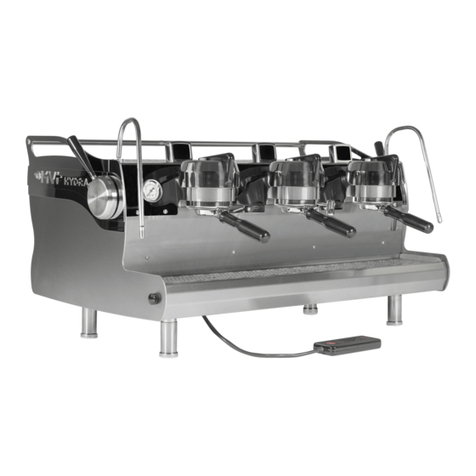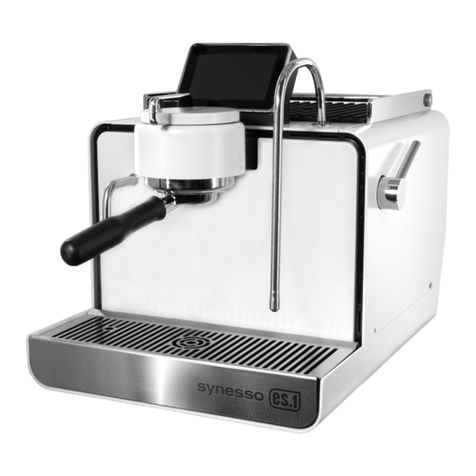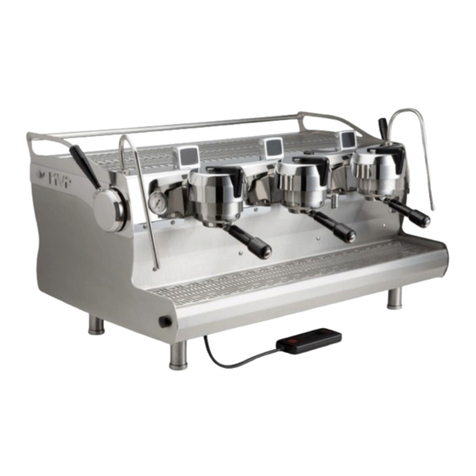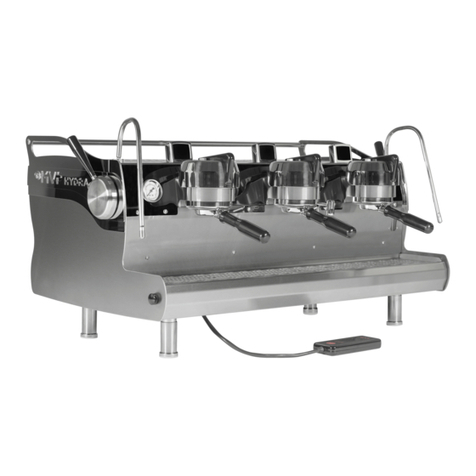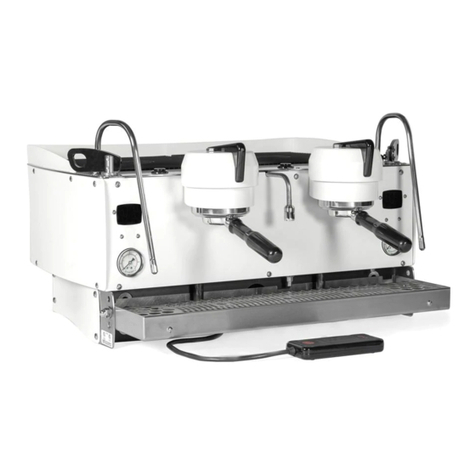Front of machine
View of top of
1 group machine
Foot diameter
3.1cm / 1.25"
Steam handle
7 cm
3"
59 cm / 23"
30 cm / 12"
15 cm
6"
8.5cm
Legend:
X: 1 group: 39.5cm / 16"
2 group: 67cm / 26"
3 group: 94cm / 37"
Y: 1 group: 21cm / 8"
2 group: 48 cm / 19"
3 group: 76cm / 30"
14 cm
5.5"
INSTALLATION DIAGRAM
MACHINE FOOTPRINT
4"
Hole for
hoses
6.5cm / 2.5"
X
Y
Incoming Water
Filtration System
Drain hose
Treated
water to
pump
Water from
pump to groups
Power
to
pump
Mains
power
Water Requirements
Proper water filtration and regular filter changes are a requirement to keep your factory
warranty valid and your machine functioning properly. It is highly recommended that you
contact a professional water filtration specialist in your area and have your water tested
to determine the proper filtration system.It is important to note that many municipalities
change their water sources throughout the year,so periodic water tests may be necessary.
Water Standards to keep your warranty valid:
Total Dissolved Solids (TDS) 30 to 200 ppm (parts per million)
Total Hardness - in ppm Less than 85 ppm
Total Hardness - in grains 3 to 5 grains (divide ppm by 17.1 to get grains)
pH 6 pH to 8 pH
Chloride 0 ppm - any Chlorides can be corrosive and harmful
Total Alkalinity Less than 100 ppm
Chlorine 0 ppm
Iron 0 ppm
Water
to steam
tank
Electrical requirements:
1 Group 110v: 60 hz, 20 amp
1 Group 220v: 50/60 hz, 16 amp
2 Group: 220v, 50/60 hz, 28 amp
3 Group: 220v, 50/60 hz, 36 amp
Hydra Electrical Requirements:
2 Group: 220v, 50/60 hz, 30 amp
3 Group: 220v, 50/60 hz, 40 amp
*Located within 3' of machine
Pump and Motor:
Located within 5' of the machine.
Dimensions: H 6.5"x W 5.5"x D 9.5"
Counter requirements
* Easily cleanable
* Sturdy, level and horizontal
* Capable of sustaining weights up
to 300 lbs.
* 2.5" round hole drilled for hoses
(see "Footprint" for hole location)
* Clearance: 1" behind, 3" in front
Drainage requirements:
Located within 5' of the machine.
Drain hose should run as vertically
away from the machine as possible.
Water requirement
* 3/8" cold water supply line
* Properly treated water required for
warranty (see below for details)
* Shut-off valve
* Located within 5' of the machine
* Braided stainless lines provided
Note: Hydra/hybrid machines have
multiple pumps and motors
